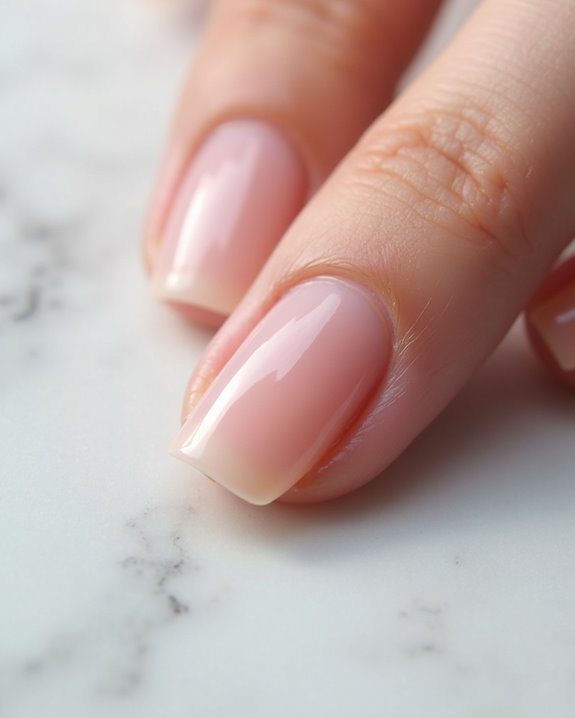Choosing the right nail drill depends on your experience level and intended use. Beginners should select models with 15,000-25,000 RPM, while professionals typically need 25,000-35,000 RPM for acrylic work. Key features include adjustable speeds, lightweight handpiece, and compatibility with standard 3/32-inch bits. Consider low-vibration options to reduce fatigue, and make sure your choice includes forward/reverse rotation capabilities. The appropriate combination of RPM range and bit selection will greatly enhance your nail service results.
Key Takeaways
- Match RPM requirements to your experience level: beginners need 15,000-25,000 RPM, while professionals require 25,000-35,000 RPM.
- Consider your primary use: natural nails need only 15,000 RPM, while acrylic nails require minimum 25,000 RPM for effective manipulation.
- Look for adjustable speeds, low vibration, and ergonomic handpiece design to reduce fatigue during extended sessions.
- Ensure compatibility with standard 3/32-inch shank bits and check if forward/reverse rotation is available.
- Choose appropriate materials: carbide bits offer durability, ceramic bits minimize heat generation during extended use.
Understanding Nail Drill RPM: What Speed Do You Need?
When selecting a nail drill, understanding the appropriate RPM (rotations per minute) is essential for both safety and effectiveness. Beginners should opt for models with a maximum speed of 25,000 RPM, which provides sufficient power for shaping and poly gel removal without risking discomfort or injury. For natural nails, 15,000 RPM generally suffices, while acrylic nails require at least 25,000 RPM for proper product manipulation.
Professional electric nail drills typically offer higher capabilities, with standard models reaching 30,000 RPM for efficient work on multiple clients. High-end professional equipment, like the Stephanee model, can achieve 35,000 RPM, enabling precise carving and cutting of false nails. Most technicians, however, operate below their drill’s maximum speed, with many finding 18,000 RPM comfortable for regular use, balancing efficiency with control.
Additionally, certain models like the Lavinda nail drill provide up to 35,000 RPM for effectively managing tough acrylic nails.
Beginner Vs Professional Nail Drill Requirements
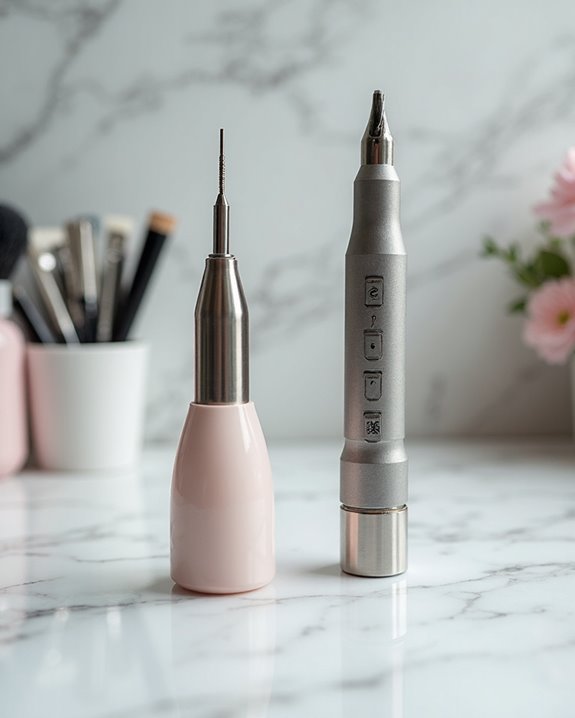
How do the requirements differ between novice users and seasoned nail technicians when selecting an appropriate nail drill? Beginners should select electric nail files with speeds up to 25,000 RPM, or as low as 15,000 RPM for natural nails care, which provides sufficient power while maintaining safety and comfort. Professionals, however, need drills that reach at least 25,000 RPM, with premium models like the Stephanee offering up to 35,000 RPM for efficient acrylic removal.
Professional-grade equipment requires minimum 30-volt power capacity and must include forward and reverse rotation options to handle multiple clients without workflow disruptions. While beginners can effectively use $30 models, professionals should invest in one costing up to $100, as the higher price reflects enhanced durability and features necessary for frequent, intensive applications in salon environments. For beginners, options like the COSLUS Cordless Electric Nail Drill provide stepless speed control to ensure gradual and safe speed adjustments during at-home manicures.
Essential Features to Look for in Quality Nail Drills
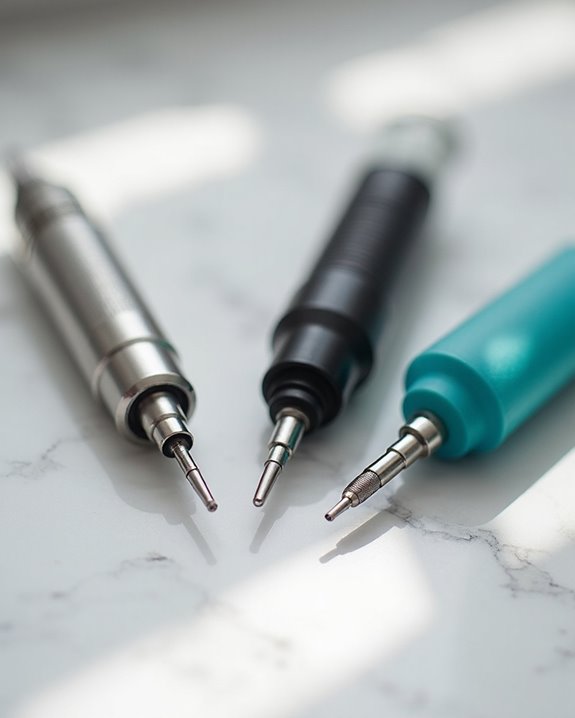
Understanding the exact capabilities of a nail drill requires careful examination of several key features before making a purchase. Quality electric nail drills should offer adjustable speeds ranging from low settings to at least 25,000 RPM for beginners or 35,000 RPM for professionals, allowing efficient work across various nail applications. The handpiece should be lightweight to prevent fatigue during extended use, while compatibility with standard 3/32-inch shank bits guarantees users can access a diverse array of bits for different techniques.
Forward and reverse rotation capabilities provide greater control when shaping nails, accommodating both left and right-handed technicians. Additionally, reputable manufacturers offer warranty protection, typically six months with options extending to one year, protecting the investment against mechanical failures. These features collectively determine whether a drill will meet specific user requirements and provide reliable performance. Furthermore, models with 8-10 hours of battery life are crucial for professionals needing uninterrupted sessions during mobile services.
Types of Nail Drill Bits and Their Specific Uses
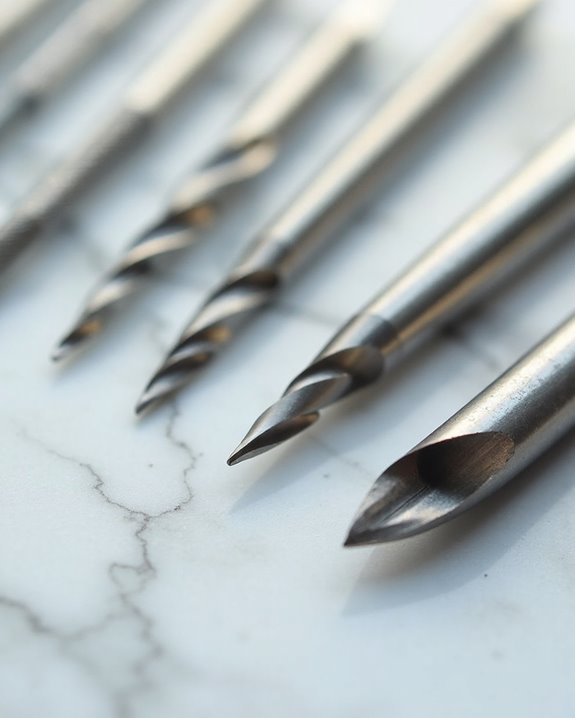
The right nail drill bit selection fundamentally determines the quality, precision, and safety of any nail enhancement procedure. Various bits in different shapes and sizes are designed for specific techniques when working with artificial nails. Barrel bits, available in large and small variations, are used to shape poly gel and for backfill cutting, while pointed under nail cleaning bits excel at accessing tight spaces beneath nails and along sidewalls. Cuticle cleaner safety bits are great for prepping the natural nail bed, helping prevent lifting issues with nail enhancements. The type of drill bit chosen directly impacts the professional’s ability to perform detailed work—cone bits are ideal for shaping toes, while tapered barrel bits and sanding bands are used to remove excess material during infills and surface preparation.
Material Matters: Choosing the Right Drill Bit Construction

Material selection for nail drill bits dramatically influences both performance and lifespan, making it a critical consideration for nail technicians seeking best results. The best nail drills on the market feature a variety of materials tailored to specific functions, with each construction type offering unique advantages. Mandrel bits, typically metal or rubber, serve as holders for disposable sanding bands that effectively remove gel polish in different grits. For work on both natural and acrylic nails, professionals often opt for a drill with gold or silver carbide bits, prized for their durability and reusability. Electric nail files equipped with ceramic bits present an excellent alternative, as their specialized flute cut design minimizes heat generation during extended use. The depth and size of these flute cuts determine the grit level, affecting the bit’s aggressiveness and precision.
Finding Your Price Point: Budget to Premium Options
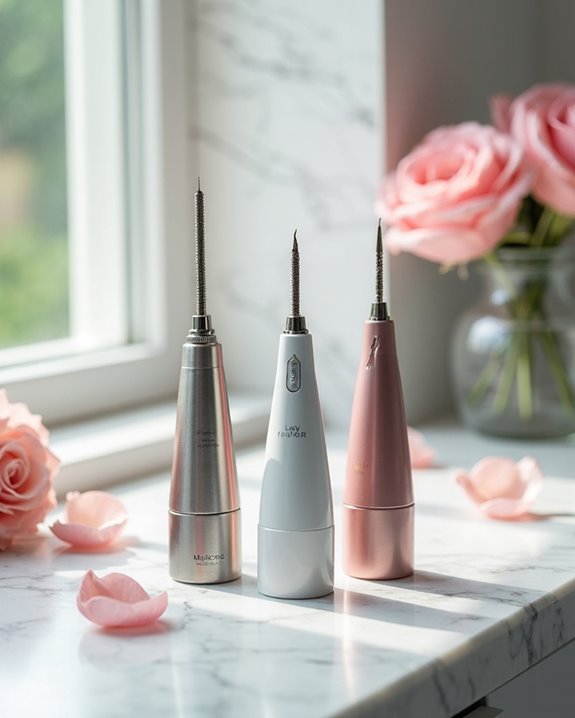
While material construction determines a nail drill’s performance capabilities, selecting the appropriate price point guarantees professionals obtain tools that match their specific needs and workflow demands. The market offers options spanning from under $10 to over $250, with Makartt recommending $30 models for beginners and up to $100 for professional nail technicians seeking higher RPMs and durability.
Entry-level devices like the $25 Own Harmony Electric Nail Buffer provide sufficient power for basic maintenance, while mid-range options like the $80 Beurer Rechargeable Device offer enhanced features that improve the accuracy of your work. Premium models above $100 represent investments that experienced nail techs should consider, as a quality drill allows for more efficient service on client’s nails. The portable nail options at each price point create a thorough Guide to Nail Drill selection based on budget and requirements.
Portability Factors: Corded, Cordless, and Base Designs
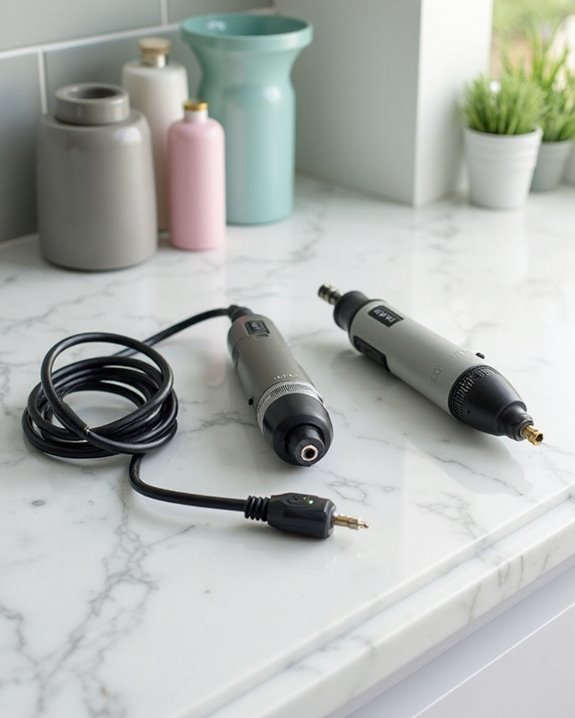
When selecting a nail drill, portability considerations dramatically impact both workflow efficiency and work environment flexibility. Corded models like the Subay Professional Electric Drill offer reliable power for heavy-duty nail work but remain tethered to outlets, limiting movement during use. Conversely, cordless options such as the Hugmaplepro Portable Nail Drill provide eight to ten hours of battery life, ideal for technicians who service nails at home or in various locations.
Base design greatly affects mobility; drills that require a body for operation reduce portability but enhance stability when used with a foot pedal. The Stephanee nail drill comes with a belt buckle feature, allowing technicians to move freely while maintaining access to their tool. For maximum flexibility, the Beurer device offers Foot mode operation and bidirectional rotation, ensuring precise work on nails without cord restrictions.
Maintaining Your Nail Drill for Longevity
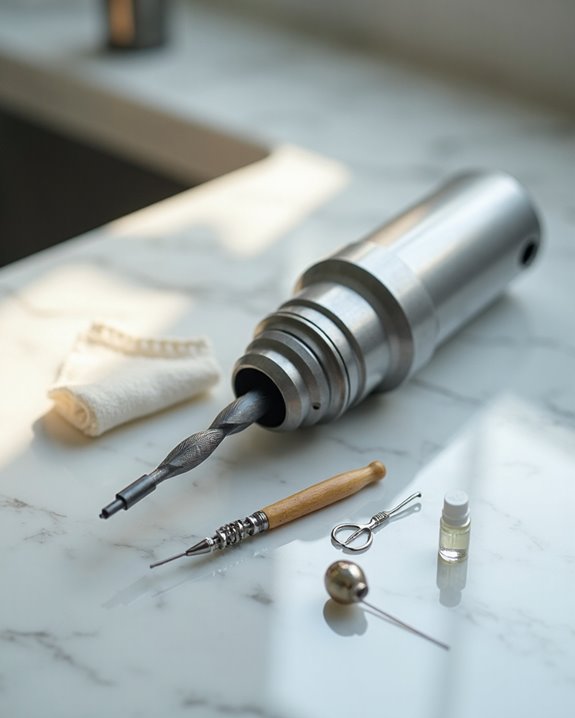
The lifespan of a professional nail drill depends largely on how well it is maintained after purchase, with proper care routines directly influencing both performance quality and operational duration. Regular sanitization of drill bits before and after each use helps remove bacterial buildup that can cause damage to both the device and clients. Storage in cool, dry environments is essential to make sure environmental factors don’t affect the accuracy of the tool during operation.
Users should monitor for overheating, particularly during extended sessions, as excessive heat can go wrong quickly, compromising motor integrity. Following manufacturer-recommended maintenance schedules can effectively extend the warranty period, with some companies offering unlimited warranty options for well-maintained devices. Low-vibration models typically require less maintenance while delivering consistent performance, preventing premature wear that might otherwise necessitate costly replacements.
Specialized Nail Drills for Specific Techniques

Selecting specialized nail drills tailored to particular techniques guarantees ideal results while minimizing potential damage to natural or artificial nails during professional and at-home treatments. The Hugmaplepro Portable Nail Drill, with its powerful 30,000 RPM motor and seven attachments, excels specifically for acrylic nail techniques, providing efficient removal and shaping capabilities. For natural nail manicure techniques, the Beurer Rechargeable Device offers precision with its moderate 3,200-4,400 RPM range and LED light enhancement. The Seamind Cordless Kit, featuring adjustable speeds from 2,900 to 4,200 RPM, specializes in pedicure techniques focused on callus removal with five targeted attachments. Beginners benefit from the Own Harmony Buffer’s gentle 2,000 RPM, while professional technicians requiring heavy-duty applications may prefer the Subay Professional’s robust 20,000 RPM motor with precise speed control.
Safety Considerations When Operating Electric Nail Files
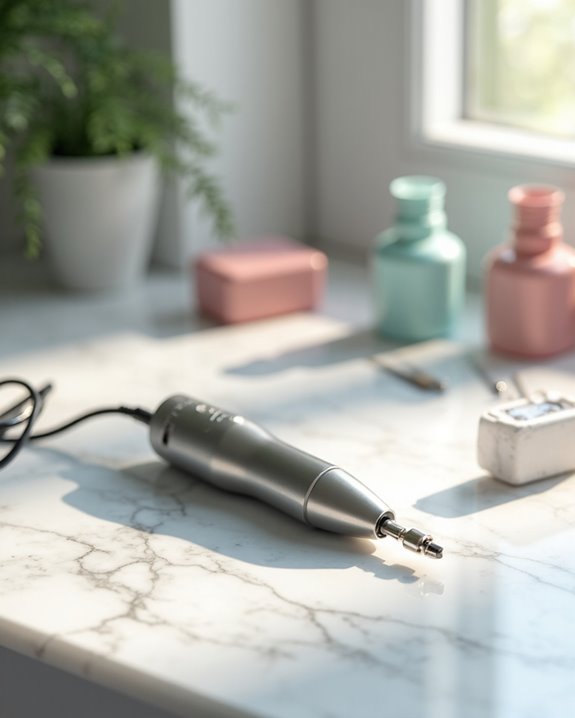
Operating electric nail files safely requires proper training and technical knowledge to prevent potentially serious complications during manicure and pedicure procedures. Board-certified dermatologist Karan Lal emphasizes that only trained professionals should handle these devices, as improper technique can result in infections or painful nail damage. When selecting equipment, practitioners should prioritize models with low vibration features to minimize the risk of hand-arm vibration syndrome and reduce heat generation that could harm nail beds.
Users must adjust RPM settings appropriately for each task, limiting speeds to 15,000 RPM for natural nails to prevent excessive filing. Proper sanitation protocols are equally critical; technicians should thoroughly sanitize drill bits before and after each client to prevent cross-contamination. Additionally, operators should avoid extended use periods, as devices like the Hugmaplepro model can overheat, potentially causing burns or equipment failure.
Frequently Asked Questions
Which Nail Drill Bits to Use for What?
Like a craftsman’s toolbox, bit selection requires understanding specific shapes and grit choices. Barrel bits for backfilling, pointed bits for cleaning, cuticle bits for prep, cones for versatility, and tapered barrels for surface work offer complete material uses.
How Do I Choose the Right Nail File?
Choosing the right nail file requires consideration of file material, grit selection, and shape variety. Consumers should evaluate brand choices, usage techniques, durability factors, and proper storage methods to achieve best performance and longevity.
What Speed Should My Nail Drill Be On?
While beginners stare at dials in confusion, speed basics matter. For natural nails, 15,000 RPM suffices; beginners should stay under 25,000. Professionals handling acrylics benefit from 30,000 RPM. Speed control prevents nail damage; ideal RPM depends on experience.
Are All Nail Drills the Same?
No, nail drills vary greatly across brand comparisons, power sources, feature differences, and design variations. They differ in material types, price ranges, and user ratings, offering diverse options to meet specific nail care requirements.


